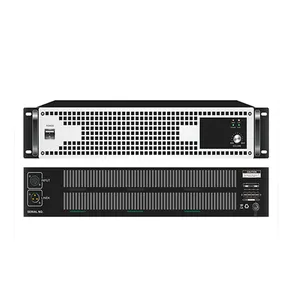Types of High Voltage Power Amplifiers
The high voltage power amplifier is critical for many industries, so it's essential to know that there are different models to meet different requirements. These include the linear amplifier, class D amplifier, switching amplifier, and audio amplifier.
High voltage linear amplifiers are often used for bandwidth and low noise applications. The input signal of these amplifiers can control the output voltage. These amplifiers work with intermediaries and radio frequencies and are often used in communication devices.
Class D power amplifiers are known for efficiency and modulation. These amplifiers use feedback to modulate the supply voltage. Thanks to this feedback, these amplifiers reduce distortion and increase amplification. Due to their efficiency, these amplifiers are often used for subwoofers and speakers.
The switching power amplifier produces power at different operating voltages. These amplifiers create a rectangular input signal which then creates a high-voltage output. These amplifiers are mostly used to amplify RF signals for testing in electronic circuits.
Audio amplifiers can increase audio signals for different high-voltage power amplifier circuits. These signals can come from different sources like radios and microphones. The input audio signal is then increased and sent to the speakers. The purpose of these amplifiers is to raise the volume without changing the quality of the sound. These amplifiers use transistors that are important for AC signal processing and can raise the power of a weak audio input to a higher output level.
Choosing the right high-power radio frequency amplifier depends on the work that is going to be done. High voltage amplifiers increase the strength of weak voltages so that the signal can be transmitted without distortion. They take a low-voltage input and produce a high-voltage output. Some models deal with audio signals, while others handle voltage or frequency testing in electronic equipment. The two areas where high-voltage power amplifiers are mostly needed are telecommunications and industrial applications. Power amplifiers are essential for improving signal quality in electronic equipment or testing in RF environments.
Function & Features
- Power Handling: High-voltage amplifiers have high power handling. They have efficient heat sinks and cooling systems for safe operation at high power levels.
- Gain Control: These amplifiers have gain control to adjust the level of amplification to the user's needs. Some have a stepped control, while others have a more precise digital control.
- Impedance Matching: High-voltage amplifiers effectively drive loads with different impedances because they have good impedance matching. This prevents signal reflections and maximizes power transfer.
- Bandwidth: The bandwidth of these amplifiers is wide enough so that all the frequency components of the signal get through without any distortion.
- Status Monitoring: Some high-voltage amplifiers have status monitoring features. They have output voltage and current monitoring, temperature sensors, and diagnostic tools for potential issues.
- Robustness: High-voltage amplifiers are built to be reliable. They are put through strict testing and inspection in order to make sure they reliably produce high power in challenging environments.
Scenarios of High Voltage Power Amplifier
High voltage power amplifiers are crucial amplifying tools that find applications in various industries and research fields.
- Medical ultrasound: High voltage ultrasound amplifiers increase the amplitude of ultrasound signals that assist in medical imaging and therapeutic applications. The amplified signals penetrate deeper into the patient's tissues for diagnostic imaging and other therapeutic procedures.
- Ultrasonic cleaning: In ultrasonic cleaning, high voltage amplifiers serve to boost ultrasonic frequencies for the generation of cavitation bubbles in a liquid solution to clean intricate machine parts, jewelry, or surgical instruments.
- Industrial inspection: Industrial inspection employs non-destructive testing techniques to ascertain the structural integrity of industrial equipment. Amplifiers boost the ultrasound signals needed for the inspection of welding joints, metal casts, and other industrial parts.
- Sonar and seismic exploration: Power amplifiers are key elements in sonar and seismic exploration. They generate high-intensity ultrasound signals used in underwater exploration or geological investigation.
- RFV (radiofrequency vacuum): Radiofrequency vacuum models are widely used in weight loss, rejuvenation, and skin tightening. They exploit radiofrequency energy to produce heat and induce collagen contraction and body fat reduction. Amplifiers provide the needed power for the generation of radiofrequency energy.
- Laser ultrasound transducers: High voltage transducers can be laser-based. They serve to convert ultrasound signals into electrical signals for measurement systems in optimal conditions.
- Research laboratories: Various research applications in laboratories depend on high voltage power amplifiers and their ability to control output levels. These applications involve material science, characterized by applying forces to stretch or compress materials; plasma physics for plasma generation and confinement; and electron beams in the investigation of fundamental particle properties.
How to choose high voltage power amplifier
When selecting a high-voltage amplifier, thorough consideration of important characteristics tailored to particular requirements is critical.
- Volts per amplifier: Amplifier output voltage is a crucial factor in the amplifier selection process. If more than 30 V output is required, use an amplifier circuit with a high-voltage output.
- Bandwidth: The bandwidth of an amplifier is the range of frequencies it can handle. An amplifier's bandwidth is calculated by deducting the lower-cutoff frequency from the upper-cutoff frequency. A high voltage amplifier should have a large bandwidth to accommodate a wide frequency range of input signals.
- Gain: Gain is a significant factor to consider when selecting an amplifier. Amplifiers with different voltage gains are available. An amplifier with a voltage gain of 1 is known as a unity-gain amplifier, while an amplifier with a voltage gain of 1000 is called a high-gain amplifier. An amplifier's gain is determined by multiplying its input and output voltages.
- Current output: The amount of current an amplifier can deliver is its current output. This value must be known to properly supply the intended load. If the current output is not adequate, the amplifier will not work.
- Load impedance: Load impedance is the resistance value at which a load is connected. It is crucial to know the load impedance to select an appropriate amplifier.
- Number of channels: Amplifiers with multiple or single channels are available. An amplifier with one channel is called a mono amplifier, while an amplifier with two to six channels is referred to as a multi-channel amplifier.
- Package: The amplifier's package type is another essential factor to consider. High-voltage amplifiers come in TO-18, TO-39, DIP, and SOIC packages. SOIC, DIP, and TO-39 packages can be mounted on a PCB, but the mount type will depend on the PCB design.
- Temperature range: Every electronic component operates within a defined temperature range. Each amplifier is designed to work in different temperature conditions, like industrial, automotive, and consumer grade.
- Power supply voltage: Power supply voltage is another crucial factor to consider. Power supply voltage should be avoided as a source of amplifier circuit fault. Typical values of power supply voltage are ±5 V, ±15 V, +24 V, +30 V, +48 V, etc.
- Frequency: All amplifiers do not operate in the same frequency range. To obtain an amplifier that operates in the desired frequency range, the frequency characteristics of the amplifier circuit should be considered.
- Noise: Noise is another important factor to consider when selecting an amplifier. Amps with a Signal-to-Noise ratio of 90 decibels or greater are ideal.
High voltage power amplifier Q and A
Q1: What applications use high voltage power amplifiers?
A1: These HV PAs are used in applications such as RF crystal oscillator for radio transmitters, transducer drivers for ultrasonic cleaning devices, and clock generation for digital circuits.
Q2: Are high voltage amplifiers linear or non-linear?
A2: High voltage amplifiers can be both linear and non-linear. A linear amplifier needs to produce an output signal proportional to the input signal without distortion, while a non-linear amplifier generates signals of different frequencies, which are called harmonics of the fundamental frequency.
Q3: What is the use of a voltage amplifier?
A3: An amplifier's main purpose is to increase the voltage of a weak signal and provide the output to drive a loudspeaker, etc. If an amplifier cannot increase the voltage, it will not have any significance in its construction.
Q4: What are the characteristics of a power amplifier?
A4: The ideal power amplifier will have high input impedance, low output impedance, and it should be able to deliver a maximum output without distortion to the maximum signal voltage.


















































































































































































































